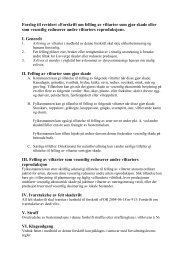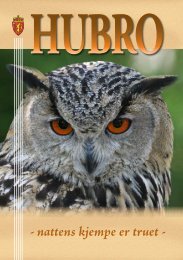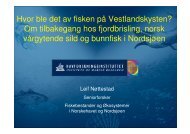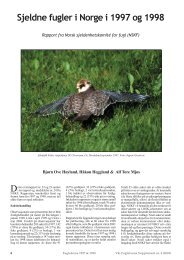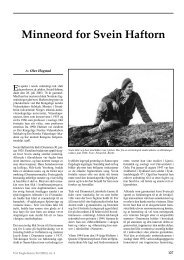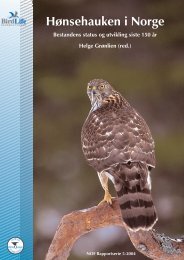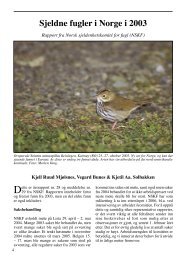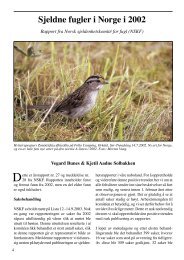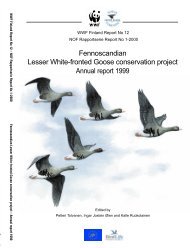Dverggås i Norge. Kunnskapsstatus og forslag til nasjonal ...
Dverggås i Norge. Kunnskapsstatus og forslag til nasjonal ...
Dverggås i Norge. Kunnskapsstatus og forslag til nasjonal ...
Create successful ePaper yourself
Turn your PDF publications into a flip-book with our unique Google optimized e-Paper software.
SUMMARY<br />
Norsk Ornitol<strong>og</strong>isk Forening – Rapport 3-2008<br />
The Lesser White-fronted Goose Anser erythropus is globally threatened, being rec<strong>og</strong>nised as<br />
Vulnerable by IUCN and ranked as Critically Endangered within Norway. The Lesser Whitefronted<br />
Goose is a long-distance Palearctic migrant, currently breedingdiscontinuously in the subarctic<br />
zone from northern Fennoscandia to eastern Siberia. At present, only Norway and Russia<br />
have breeding populations of wild Lesser-White-fronted Geese, and the wintering/staging areas<br />
and migration routes are only partially known. The global population has declined rapidly since<br />
the middle of the 20th century. The decrease in numbers has been accompanied by fragmentation<br />
of the breeding range, giving rise to fears that the species will go extinct unless the downward<br />
trend is halted and reversed. Overhunting and habitat loss are considered to be the main threats.<br />
Three subpopulations of wild Lesser White-fronted Geese can be rec<strong>og</strong>nised:<br />
• Fennoscandian population (at present breeding almost exclusively in Norway, and formerly also<br />
in Sweden, Finland and the Kola Peninsula in north-westernmost Russia).<br />
• Western main population (breeding in northern Russia to the west of the Taimyr Peninsula).<br />
• Eastern main population (breeding from the Taimyr Peninsula eastwards and wintering in<br />
China).<br />
The Fennoscandian population underwent significant declines during the twentieth century and<br />
continue to decrease, due primarily to hunting pressure and habitat loss. At present, only 15-20<br />
breeding pairs are left, most of them breeding within a restricted core area in Finnmark County in<br />
Norway. This proposal for a National Action Plan deals with conservation of the Fennoscandian<br />
population, but as this population has a complicated migration system that allows part of the<br />
population to migrate along with the Western main population in autumn, this proposal do also to<br />
a certain degree affect the Western main population. In Norway, the Norwegian Ornithol<strong>og</strong>ical<br />
Society (NOF) has monitored this population since 1990, and the results from the monitoring, as<br />
well as the results from research activities run jointly by NOF and WWF-Finland since 1994, has<br />
made the foundation for this proposal. In the period 2005-2008, N orway (represented by NOF and<br />
the Directorate for nature management (DN)) has participated in a LIFE-EU project for<br />
conservation of Lesser White-fronted Goose on the European migration route. A final National<br />
Action Plan published by DN is one of the sub-projects.<br />
There is strong evidence that the most important factors driving the continued decline in numbers<br />
and fragmentation of range of the Lesser White-fronted Goose (both the Fennoscandian and<br />
Western main subpopulations) are those that cause high mortality among fully grown birds. It is<br />
also clear that these factors operate primarily on the staging and wintering grounds. Although the<br />
species is legally protected, on paper at least, across virtually its entire range, hunting is<br />
considered to be the primary cause of mortality and the single most important threat that this<br />
Action Plan has to tackle.<br />
The goal of this proposal for a Norwegian National Action Plan for Lesser White-fronted Goose is<br />
to restore the species to a favourable conservation status in Fennoscandia. The proposal also takes<br />
into account the population derived from captive-bred birds and used for restocking in Swedish<br />
Lapland. Due to the genetic composition of these birds, they are considered a potential threat to<br />
the Fennoscandian population.<br />
The results required for delivering this purpose and goal is:<br />
Action result 1: Survival improved.<br />
Action result 2: Further habitat loss and degradation is prevented.<br />
Action result 3: Reproductive success is maximised.<br />
Action result 4: No intr<strong>og</strong>ression of DNA from other goose species into the wild population<br />
occurs as a result of further releases and DNA intr<strong>og</strong>ression from already released birds<br />
from captive breeding pr<strong>og</strong>rammes is minimised.<br />
Action result 5: Key knowledge gaps filled.<br />
Action result 6: Information on the species’ status communicated to all interested parties.<br />
5



